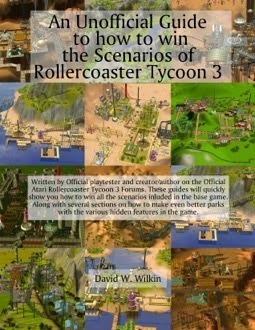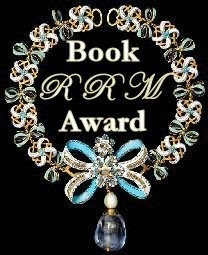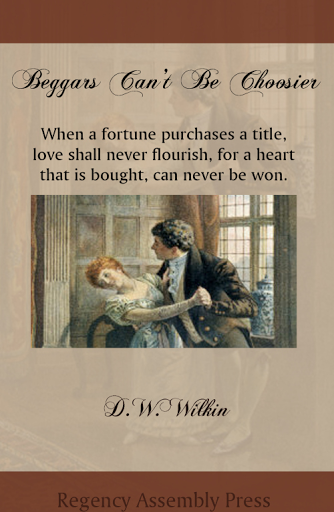D.W. Wilkin's Blog, page 156
February 2, 2015
Space Opera Books presents ECO Agents:Save The Planet a Young Adult Adventure
First ECO Agents book available
Those who follow me for a long time know that I also write in other fields aside from Regency Romance and the historical novels I do.
A few months ago, before the end of last year and after 2011 NaNoWriMo, (where I wrote the first draft of another Regency) I started work on a project with my younger brother Douglas (All three of my brothers are younger brothers.)
The premise, as he is now an educator but once was a full on scientist at the NHI and FBI (Very cloak and dagger chemistry.) was that with the world having become green, and more green aware every week, why not have a group of prodigies, studying at a higher learning educational facility tackle the ills that have now begun to beset the world.
So it is now released. We are trickling it out to the major online channels and through Amazon it will be available in trade paperback. Available at Amazon for your Kindle, or your Kindle apps and other online bookstores. For $5.99 you can get this collaboration between the brothers Wilkin. Or get it for every teenager you know who has access to a Kindle or other eReader.
Barnes and Noble for your Nook Smashwords iBookstore for your Apple iDevices Amazon for your Kindle
Five young people are all that stands between a better world and corporate destruction. Parker, Priya, JCubed, Guillermo and Jennifer are not just your average high school students. They are ECOAgents, trusted the world over with protecting the planet.
Our Earth is in trouble. Humanity has damaged our home. Billionaire scientist turned educator, Dr. Daniel Phillips-Lee, is using his vast resources to reverse this situation. Zedadiah Carter, leader of the Earth���s most powerful company, is only getting richer, harvesting resources, with the aid of not so trustworthy employees.
When the company threatens part of the world���s water supply, covering up their involvement is business as usual. The Ecological Conservation Organization���s Academy of Higher Learning and Scientific Achievement, or simply the ECO Academy, high in the hills of Malibu, California overlooking the Pacific Ocean, is the envy of educational institutions worldwide.
The teenage students of the ECO Academy, among the best and brightest the planet has to offer, have decided they cannot just watch the world self-destruct. They will meet this challenge head on as they begin to heal the planet.
Feedback
If you have any commentary, thoughts, ideas about the book (especially if you buy it, read it and like it ;-) then we would love to hear from you.

February 1, 2015
Regency Personalities Series-Sir David Dundas (Politician)
Regency Personalities Series
In my attempts to provide us with the details of the Regency, today I continue with one of the��many period notables.
Sir David Dundas (Politician)
1799���1877
Sir David Dundas was a Scottish lawyer and Liberal politician.
Dundas was educated at Westminster School and at Christ Church, Oxford. He was called to the Bar at the Inner Temple in 1823, and appointed Queen’s Counsel in February 1840.
He was elected to represent Sutherland in Parliament as a Liberal in March 1840. In July 1846 he was appointed Solicitor General for England and Wales. At the time, it was the normal practice that accepting ministerial office caused a by-election; he was re-elected on 28 July. In February 1846 he was knighted, a traditional perquisite of the office, but he resigned the position in March 1848 due to ill-health and returned to the backbenches. In May 1849 he was appointed Judge Advocate General, again re-elected in a by-election on 5 June, and made a member of the Privy Council on 29 June.
He retired from politics in the 1852 general election, and was succeeded by the Marquess of Stafford, also a Liberal.
In retirement he lived and worked in his chambers at the Inner Temple; among other work, he served as a Trustee of the British Museum. His retirement from politics was not permanent; when Stafford was elevated to the House of Lords in March 1861 on becoming the third Duke of Sutherland, Dundas returned to Parliament. He stood down again in May 1867, being succeeded by Lord Ronald Sutherland-Leveson-Gower, the Duke’s younger brother.

January 31, 2015
Regency Personalities Series-John Ponsonby 1st Viscount Ponsonby
Regency Personalities Series
In my attempts to provide us with the details of the Regency, today I continue with one of the��many period notables.
John Ponsonby 1st Viscount Ponsonby
1770 ��� 22 February 1855
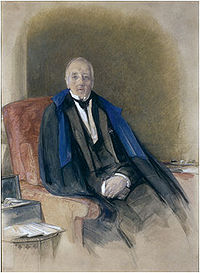
John Ponsonby
John Ponsonby 1st Viscount Ponsonby, was the eldest son of the 1st Baron Ponsonby, and brother of Sir William Ponsonby, was born about 1770. He served as a Member of Parliament (MP) in the Irish House of Commons for Tallow between 1793 and 1797. Elected in 1798 for both Banagher and Dungarvan, he elected to sit for the latter from 1798 to the Act of Union in 1800/01. He then represented Galway Borough in the United Kingdom House of Commons until 1802.
On the death of his father on 5 November 1806, he succeeded him as Baron Ponsonby, and for some time held an appointment in the Ionian Islands. On 28 February 1826 he went to Buenos Aires as envoy-extraordinary and minister-plenipotentiary until 1828 and moved then to Rio de Janeiro in the same capacity. An exceptionally handsome man, he was sent, it was reported, to South America by George Canning to please George IV, who was envious of the attention paid him by Lady Conyngham.
Once there he greatly fostered the creation of a buffer state between Argentina and Brazil to the benefit of British commerce: Uruguay. In 1830, he was entrusted with a special mission to Belgium on 1 December 1830, in connection with the candidature of Prince Leopold of Saxe-Coburg to the throne, and remained in Brussels until Leopold was elected king on 4 June 1831. His dealings with this matter were adversely criticised in ���The Guet-��-Pens Diplomacy, or Lord Ponsonby at Brussels, ������ London, 1831. But Lord Grey eulogised him in the House of Lords on 25 June 1831.
Thus, as a diplomat, he was sent twice by the British Empire to promote the instauration of buffer states to protect its interests, Uruguay and Belgium, both of which survive to this very day, still deeply similar to their bigger neighbours. In addition to this, Ponsonby was envoy to Naples from 8 June to 9 November 1832, ambassador at Constantinople from 27 November 1832 to 1841, and ambassador at Vienna from 10 August 1846 to 31 May 1850.
Through Lord Grey, who had married his sister Mary Elizabeth, he had great influence, but his conduct as an ambassador sometimes occasioned embarrassment to the ministry. He was, however, a keen diplomatist of the old school, a shrewd observer, and a man of large views and strong will. He was gazetted G.C.B. on 3 March 1834, and created Viscount Ponsonby, of Imokilly in the County of Cork on 20 April 1839.
The viscount had married, on 13 January 1803, Elizabeth Frances Villiers, fifth daughter of George Villiers, 4th Earl of Jersey. She died at 62 Chester Square, London, on 14 April 1866, having had no issue. Ponsonby published ���Private Letters on the Eastern Question, written at the date thereon,��� Brighton, 1854, and died at Brighton on 21 February 1855. The viscounty thereupon lapsed, but the barony devolved on his nephew William, son of Sir William Ponsonby.

January 30, 2015
Regency Personalities Series-Augustus FitzGerald 3rd Duke of Leinster
Regency Personalities Series
In my attempts to provide us with the details of the Regency, today I continue with one of the��many period notables.
Augustus FitzGerald 3rd Duke of Leinster
21 August 1791 ��� 10 October 1874
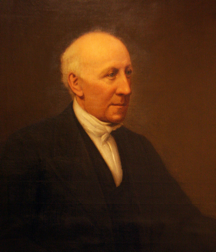
Augustus FitzGerald
Augustus FitzGerald 3rd Duke of Leinster was an Irish peer and freemason, styled Marquess of Kildare from birth until 1804. He was born and died in Carton House.
FitzGerald was the eldest surviving son of William FitzGerald, 2nd Duke of Leinster and his wife, Emilia. He inherited his father’s dukedom in 1804. On 16 June 1818, Leinster married Lady Charlotte Augusta Stanhope (15 February 1793 ��� 15 February 1859), the third daughter of Charles Stanhope, 3rd Earl of Harrington. They had four children:
Charles FitzGerald, 4th Duke of Leinster (1819���1887)
Lord Gerald FitzGerald (London, 6 January 1821 – 23 September 1886), married Anne Agnes Barker
Lady Jane Seymour FitzGerald (died 3 November 1898), married George William John Repton
Lord Otho Augustus FitzGerald (1827���1882)
In 1813, he was chosen Grandmaster of the Grand Lodge of Ireland, a post he held until his death in 1874. Leinster was appointed Custos Rotulorum of Kildare in 1819 and Lord Lieutenant of Kildare in 1831, holding both posts for life. In 1831, he was admitted to the Privy Council of Ireland and to the Privy Council of Great Britain and was Lord High Constable of Ireland at the coronations of William IV and Queen Victoria. He was a Commissioner of National Education for Ireland from 1836 to 1841.

Space Opera Books Presents A Trolling We Will Go Omnibus:The Latter Years
A Trolling We Will Go Omnibus:The Latter Years
Not only do I write Regency and Romance, but I also have delved into Fantasy.
The Trolling series, is the story of a man, Humphrey. We meet him as he has left youth and become a man with a man���s responsibilities. He is a woodcutter for a small village. It is a living, but it is not necessarily a great living. It does give him strength, muscles.
We follow him in a series of stories that encompass the stages of life. We see him when he starts his family, when he has older sons and the father son dynamic is tested.
We see him when his children begin to marry and have children, and at the end of his life when those he has loved, and those who were his friends proceed him over the threshold into death.
All this while he serves a kingdom troubled by monsters. Troubles that he and his friends will learn to deal with and rectify.
Here are the last two books together as one longer novel.
Trolling, Trolling, Trolling Fly Hides! and We���ll All Go a Trolling.
Available in a variety of formats.
For $5.99 you can get this fantasy adventure.
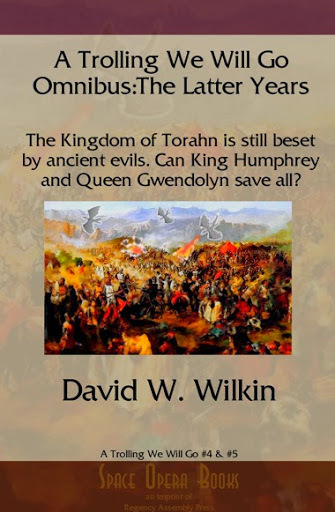
Barnes and Noble for your Nook
The stories of Humphrey and Gwendolyn. Published separately in: Trolling, Trolling, Trolling Fly Hides! and We’ll All Go a Trolling. These are the tales of how a simple Woodcutter who became a king and an overly educated girl who became his queen helped save the kingdom of Torahn from an ancient evil. Now with the aid of their children and their grandchildren.
Long forgotten is the way to fight the Trolls. Beasts that breed faster than rabbits it seems, and when they decide to migrate to the lands of humans, their seeming invulnerability spell doom for all in the kingdom of Torahn. Not only Torahn but all the human kingdoms that border the great mountains that divide the continent.
The Kingdom of Torahn has settled down to peace, but the many years of war to acheive that peace has seen to changes in the nearby Teantellen Mountains. Always when you think the Trolls have also sought peace, you are fooled for now, forced by Dragons at the highest peaks, the Trolls are marching again.
Now Humphrey is old, too old to lead and must pass these cares to his sons. Will they be as able as he always has been. He can advise, but he does not have the strength he used to have. Nor does Gwendolyn back in the Capital. Here are tales of how leaders we know and are familiar with must learn to trust the next generation to come.
Feedback
If you have any commentary, thoughts, ideas about the book (especially if you buy it, read it and like it ;-) then we would love to hear from you.

January 29, 2015
Regency Personalities Series-Thomas Reynolds-Moreton 1st Earl of Ducie
Regency Personalities Series
In my attempts to provide us with the details of the Regency, today I continue with one of the��many period notables.
Thomas Reynolds-Moreton 1st Earl of Ducie
31 August 1776 ��� 22 June 1840
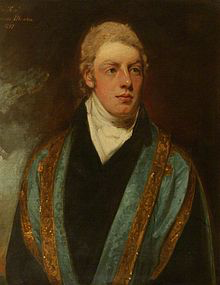
Thomas Reynolds-Moreton
Thomas Reynolds-Moreton 1st Earl of Ducie was the son of Francis Reynolds-Moreton, 3rd Baron Ducie and Mary Provis. and was educated at Eton College and Exeter College, Oxford. He succeeded to the title of 4th Baron Ducie of Tortworth on 19 August 1808.
He was elected a Fellow of the Royal Society in 1814. He was created 1st Earl of Ducie on 28 January 1837.
He married Lady Frances Herbert, daughter of Henry Herbert, 1st Earl of Carnarvon and Lady Elizabeth Alicia Maria Wyndham on 6 December 1797.

An Unofficial Guide to how to win the Scenarios of Rollercoaster Tycoon 3
An Unofficial Guide to how to win the Scenarios of Rollercoaster Tycoon 3
I have been a fan of this series of computer games since early in its release of the very first game. That game was done by one programmer, Chris Sawyer, and it was the first I recall of an internet hit. Websites were put up in dedication to this game where people showed off their creations, based on real amusement parks. These sites were funded by individuals, an expense that was not necessarily as cheap then as it is now. Nor as easy to program then as it might be to build a web page now.
Prima Books released game guides for each iteration of the game, Rollercoaster Tycoon 1, Rollercoaster Tycoon 2 and Rollercoaster Tycoon 3 (RCT3) but not for the expansion sets. And unlike the first two works, the third guide was riddle with incorrect solutions. As I played the game that frustrated me. And I took to the forums that Atari, the game publisher hosted to see if I could find a way to solve those scenarios that the Prima Guide had written up in error. Not finding any good advice, I created my own for the scenarios that the ���Official��� Guide had gotten wrong.
Solutions that if you followed my advice you would win the scenario and move on. But if you followed the
���Official��� version you would fail and not be able to complete the game. My style and format being different than the folks at Prima, I continued for all the Scenarios that they had gotten right as well, though my solutions cut to the chase and got you to the winner���s circle more quickly, more directly.
My contributions to the ���Official��� Forum, got me a place as a playtester for both expansions to the game, Soaked and Wild. And for each of these games, I wrote the guides during the play testing phase so all the play testers could solve the scenarios, and then once again after the official release to make changes in the formula in case our aiding to perfect the game had changed matters. For this, Atari and Frontier (the actual programmers of the game) placed me within the game itself.
And for the longest time, these have been free at the ���Official��� Forums, as well as my own website dedicated to the game. But a short time ago, I noticed that Atari, after one of its bankruptcies had deleted their forums. So now I am releasing the Guide for one and all. I have added new material and it is near 100 pages, just for the first of the three games. It is available for the Kindle at present for $2.99.
(Click on the picture to purchase)
Not only are all 18 Scenarios covered, but there are sections covering every Cheat Code, Custom Scenery, the famous Small Park Competition, the Advanced Fireworks Editor, the Flying Camera Route Editor which are all the techniques every amusement park designer needs to make a fantastic park in Rollercoaster Tycoon 3.

January 28, 2015
Regency Personalities Series-Andrew Snape Douglas
Regency Personalities Series
In my attempts to provide us with the details of the Regency, today I continue with one of the��many period notables.
Andrew Snape Douglas
8 October 1761 ��� 4 June 1797
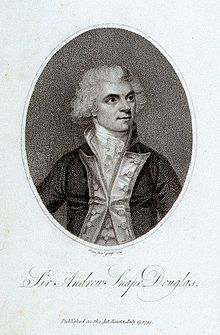
Andrew Snape Douglas
Sir Andrew Snape Douglas was born in Edinburgh on 8 October 1761, the son of Dr. William Douglas, a medical doctor of Springfield, and Lydia Hamond, daughter of a London merchant and shipowner. William Douglas’s death in 1770 led Andrew to sign on that year aboard his maternal uncle, Sir Andrew Snape Hamond’s ship, the 32-gun frigate HMS��Arethusa. The two sailed to North America, and after spending time along the coast, Douglas moved to the West Indies. With the outbreak of the American War of Independence in 1775 he returned to North America and rejoined his uncle, now commanding the 44-gun HMS��Roebuck. He received his commission as a lieutenant on 23 April 1778, and was made master and commander on 16 February 1780. He was to have been appointed to the armed ship Germain, but instead took command of a floating battery, and was present at the Siege of Charleston. He was subsequently promoted to post-captain on 15 May 1780 and appointed to the command of the captured American frigate USS��Providence. Instead he had in April 1780 become commander of the Roebuck, then serving as the flagship of Vice-Admiral Mariot Arbuthnot. He went on to capture the American ships USS��Confederacy on 14 April 1781 and Protector on 5 May. He was succeeded in the command of the Roebuck by Captain John Orde in July 1781.
The Roebuck was ordered home in July 1781, but Douglas remained in American waters, having been given command of the 54-gun HMS��Chatham. He was employed in a senior position in Admiral Thomas Graves’s fleet owing to his extensive knowledge of the American coasts. He was subsequently given command of a squadron of frigates and went on to enjoy considerable success in a number of cruises. Among his captures was the 32-gun French frigate Magicienne on 2 July 1781, an action that thwarted a planned French assault on British ships in the St John River.
Douglas returned to England after the end of the war, initially spending time at Chatham Dockyard studying naval architecture, before going to sea again, mostly serving in the Mediterranean and the English Channel. Douglas commanded the 74-gun third rate HMS��Alcide from October 1787 during the period of the Spanish Armament. He was in command of the 32-gun HMS��Southampton, which had been appointed the guard ship at Weymouth, when the town was visited by King George III. Douglas conducted the King on his first voyage aboard a warship, and on 13 September 1789 King George appointed Douglas a knight bachelor. Also in 1789 Douglas and his uncle Snape Hamond were members of the court for the court martial of the mutineers of the Bounty. Douglas was then in command of the 74-gun HMS��Goliath from 1790.
The outbreak of the French Revolutionary Wars in February 1793 led to Douglas being appointed to command the 38-gun frigate HMS��Phaeton. He went on to capture five enemy vessels that year, and was involved in the capture of a French privateer and her prize, the Spanish galleon St Jago. Lord Howe arranged for Douglas to be commodore in charge of the fleet’s frigates, occasionally sending him on detached cruises. He moved aboard Howe’s flagship, the 100-gun first rate HMS��Queen Charlotte on 8 April 1794, apparently through the auspices of both his uncle and the First Lord of the Admiralty, John Pitt, 2nd Earl of Chatham. Now serving as Howe’s flag captain Douglas fought at the Glorious First of June, sustaining a severe wound to the head but refusing to leave the deck. He was appointed a Colonel of Marines on 1 June 1795 and remained as captain of the Queen Charlotte after Howe was succeeded by Lord Bridport. He commanded his ship at the Battle of Groix in 1795, earning private praise for his courage in leading his ship whilst heavily outnumbered, but little public reward.
Douglas had married Anne Burgess on 14 November 1781 in British-occupied New York City. They had one son and two daughters, Anne Hammond Douglas and Harriet Douglas. He had begun to suffer increasing ill health, complaining of persistent headaches, which eventually forced him to end his career at sea. He moved ashore but died on 4 June 1797. A subsequent autopsy revealed brain tumours, a likely result of his injury at the Glorious First of June some years before.
An engraving of Douglas is in the collection of the British National Portrait Gallery. There are several other images of Douglas; he appears in several paintings by Mather Brown and in a portrait by modern maritime artist Irwin Bevan. Douglas is primarily known today through his letters to his uncle.

January 27, 2015
Regency Personalities Series-Edward Lumpy Stevens
Regency Personalities Series
In my attempts to provide us with the details of the Regency, today I continue with one of the��many period notables.
Edward Lumpy Stevens
1735 ��� 7 September 1819
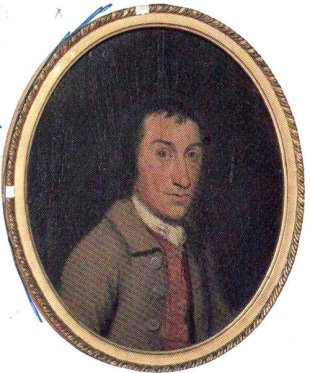
Edward Lumpy Stevens
Lumpy Stevens was an English professional cricketer who played first-class cricket from c. 1756 to 1789.
He was an outstanding bowler who is generally regarded as the first great bowler in the game’s history. He was universally known by his nickname and was always called “Lumpy” in contemporary scorecards and reports.
The beginning of Stevens’ career was before scorecards began to be kept on a regular basis from the 1772 season. He may have come from a line of cricketers as two Surrey players called Stevens are mentioned in connection with the London v Slindon match in the 1744 season. Stevens probably began playing in great matches around the mid-1750s at a time when bowlers still bowled (i.e., trundled) the ball all along the ground, as in crown green bowls. It is not known if Stevens was the first to “give the ball air” but he was certainly around when that particular revolution occurred, probably before 1770. What is known is that Stevens was the bowler who made the most careful study of flight and worked out all the implications of variations in pace, length and direction mentioned above. He became a master of his craft.
Unlike the Hambledon players who tended to represent their club only, Stevens made appearances for just about every team, including Hambledon. He is normally associated with Surrey teams in general and with the famous Chertsey club in particular. He continued as a player until he was 50 and played his last match on 2���5 September 1789 for All-England v Hampshire at Sevenoaks Vine. It is not known what took place in his career following this game, but it is suspected that Stevens enlisted in the British Army. On 20 May 1793 a letter signed by ‘A Kentish Cricketer’ written to Sporting Magazine describes an incident where an Ensign Hamilton, a member of the Sevenoaks Vine Club, had a cannonball deflected away from his head by a Sergeant. The magazine and the Maidstone Journal both linked the story to Stevens.
How he came by his legendary nickname is uncertain but it may have been because he was adept at choosing a pitch to suit his very subtle variations of pace, length and direction. In the 18th century, choice of pitch was granted to one team according to the rules in situ and it was generally the leading bowler on that team who chose the place where the wickets would be pitched. According to the famous verse:
For honest Lumpy did allow
He ne’er would pitch but o’er a brow
Stevens was a gardener by trade and his bowling prowess earned him a job on the Walton-on-Thames estate of the Earl of Tankerville, a noted patron of the game.
It is known that in a single wicket match on 22���23 May 1775, Stevens beat the great Hambledon batsman John Small three times with the ball going through the two stump wicket of the day. As a result of his protests, the patrons agreed that a third stump should be added.

RAP’s has Beggars Can’t Be Choosier
One of the our most recent Regency Romances.
Beggars has won the prestigious Romance Reviews Magazine Award for Outstanding Historical Romance:
It is available for sale and I hope that you will take the opportunity to order your copy.
For yourself or as a gift. It is now available in a variety of formats. For $3.99 you can get this Regency Romance for your eReader. A little more as an actual physical book.
When a fortune purchases a title, love shall never flourish, for a heart that is bought, can never be won.
The Earl of Aftlake has struggled since coming into his inheritance. Terrible decisions by his father has left him with an income of only 100 pounds a year. For a Peer, living on such a sum is near impossible. Into his life comes the charming and beautiful Katherine Chandler. She has a fortune her father made in the India trade.
Together, a title and a fortune can be a thing that can achieve great things for all of England. Together the two can start a family and restore the Aftlake fortunes. Together they form an alliance.
But a partnership of this nature is not one of love. And terms of the partnership will allow both to one day seek a love that they both deserve for all that they do. But will Brian Forbes Pangentier find the loves he desires or the love he deserves?
And Katherine, now Countess Aftlake, will she learn to appreciate the difference between happiness and wealth? Can love and the admiration of the TON combine or are the two mutually exclusive?
Purchase here:Amazon Kindle, Barnes and Noble Nook, Kobo, Smashwords, iBooks, & Trade Paperback
Feedback
If you have any commentary, thoughts, ideas about the book (especially if you buy it, read it and like it ;-) then we would love to hear from you.



